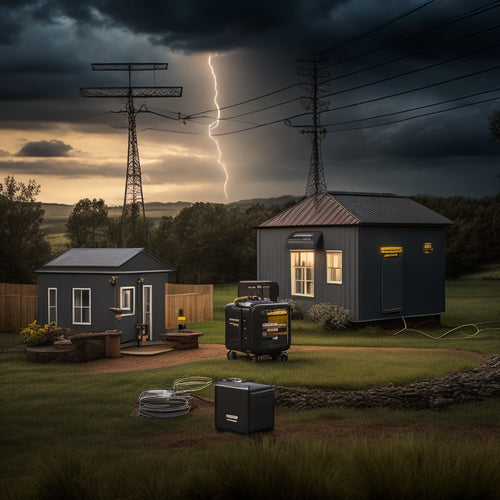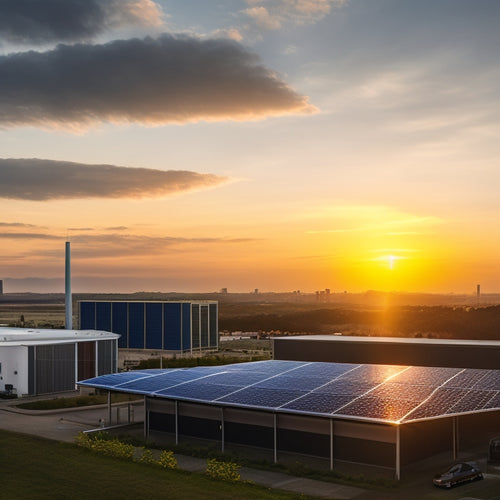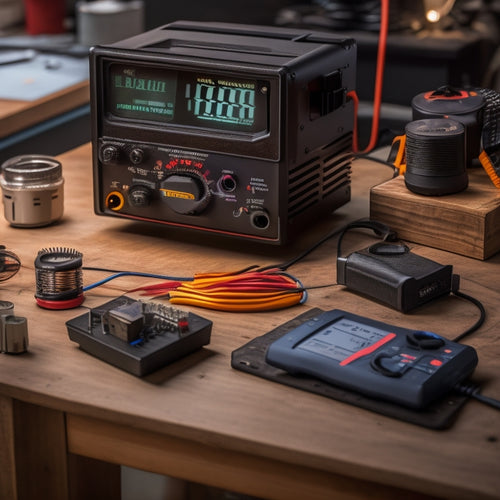
10 Essential Steps to Home Energy Independence
Share
You're taking an essential step towards energy self-sufficiency by exploring the vital steps to achieve home energy independence. Start by evaluating your energy needs, selecting the right solar panels, and sizing your system appropriately. Then, choose the best energy storage options and understand net metering laws to guarantee a seamless grid interaction. Prepare your electrical system, install your setup safely, and consider portable energy solutions. Finally, monitor your energy production and maintain your solar system to guarantee peak performance. As you initiate this expedition, you'll uncover even more significant details that will help you tap into the full potential of renewable energy.
Key Takeaways
- Assess energy consumption trends and identify areas of high energy usage to optimize energy needs and calculate daily energy requirements.
- Choose the right solar panels based on efficiency ratings, warranty options, and top brands, and size the system according to daily energy requirements.
- Select energy storage solutions that meet energy efficiency and inverter type requirements, and ensure proper installation and maintenance.
- Understand net metering laws and grid interaction regulations to navigate the complex framework of regulations and policies.
- Prepare the home's electrical system by conducting an electrical load assessment, identifying energy usage patterns, and implementing load management strategies.
Assessing Your Energy Needs
Regularly, homeowners overlook an essential step in achieving energy independence: understanding their energy needs. You must identify your energy consumption trends to determine how much energy you need to produce. This involves analyzing your past energy bills, identifying areas of high energy usage, and understanding how your energy needs may change in the future.
For instance, if you plan to purchase an electric vehicle or install energy-intensive appliances, your energy needs will increase. To guarantee accurate evaluations, it's vital to calculate daily energy requirements in watt-hours (Wh) for all appliances and systems and conduct an energy audit to make sure the renewable energy system meets energy needs.
Considering future energy technologies, such as smart grids and energy storage systems, will also help you anticipate your energy requirements. By accurately evaluating your energy needs, you can design an energy system that meets your demands, providing a reliable and efficient shift to energy independence.
Choosing the Right Solar Panels
With your energy needs assessed, you're ready to select the solar panels that will help you achieve energy independence.
You'll need to evaluate various factors, including solar panel types, such as monocrystalline, polycrystalline, and thin-film. Efficiency ratings, ranging from 15% to 22%, will impact your system's overall performance. Look for panels with thorough warranty options, typically 25 years or more.
When choosing a top brand, consider high-efficiency solar panels like those from Renogy, HQST, and WindyNation, which are recognized for their high-efficiency solar panels. Installation costs, environmental impact, and manufacturer reputation are also significant factors.
Aesthetic considerations, like panel color and frame type, may influence your decision. Finally, investigate financing options, such as loans or power purchase agreements, to make your solar dream a reality.
Sizing Your Solar Panel System
When sizing your solar panel system, you'll need to take into account several key factors, including your energy usage patterns, roof size and orientation, and local building codes and regulations.
Accurate assessment of daily energy requirements is vital for effective sizing, as it guarantees the system can handle energy-intensive appliances and optimize energy harvesting high-efficiency inverters.
The configuration of your panel array is also critical, as it affects the system's overall efficiency and performance.
System Size Factors
Sizing your solar panel system correctly is essential to achieving home energy independence, as it directly impacts the amount of electricity generated and your return on investment.
When determining the size of your system, you'll need to evaluate several factors, including your energy usage, roof size and orientation, and local building codes.
You'll also want to take into account any solar incentives that may be available to you, such as tax credits or rebates, which can help offset the cost of your system.
Additionally, energy efficiency improvements to your home, such as new windows or insulation, can reduce your energy needs and allow for a smaller system.
Panel Array Configuration
You've evaluated the key factors affecting your solar panel system's size, and now it's time to configure the panel array to maximize energy production.
Proper panel orientation is essential, as it directly impacts energy output. Ideally, panels should face south (in the northern hemisphere) and be tilted at an angle equal to your latitude.
Array spacing is also vital, as it reduces shading between panels and allows for air circulation. A general rule of thumb is to maintain a spacing of at least 6 inches between rows.
Additionally, consider using a tracker system to adjust the panel angle and orientation throughout the day, further optimizing energy production.
Selecting Energy Storage Options
As homeowners shift to renewable energy sources, they're faced with the essential task of selecting energy storage options that effectively bridge the gap between energy generation and consumption.
When choosing a storage system, you'll need to take into account factors like energy efficiency, inverter types, and battery lifespan.
Lithium batteries offer high energy density and long lifetimes, while lead acid options are more affordable but heavier.
Compare costs and weigh the pros and cons of each. Proper installation is critical, so make sure your installer follows best practices.
Maintenance needs, performance metrics, and environmental impact should also be evaluated.
Understanding Net Metering Laws
Three decades of net metering policy evolution have led to a complex framework of regulations governing how homeowners with renewable energy systems interact with the grid.
As you traverse this environment, you'll encounter varying net metering laws that impact your path to home energy independence. Understanding these laws is vital to maximizing the net metering benefits, which include offsetting your energy consumption and generating revenue from excess energy production.
However, you'll also face net metering challenges, such as policy inconsistencies, interconnection obstacles, and metering requirements.
Preparing Your Home's Electrical
You'll need to assess your home's electrical load to determine the size of the renewable energy system you require. This involves evaluating your energy usage patterns and identifying areas where you can optimize your energy consumption.
A thorough wiring and circuit check will also guarantee that your home's electrical infrastructure can safely support the new system.
Electrical Load Assessment
Your home's electrical system is a complex network that powers everything from lights and appliances to heating and cooling systems, making an electrical load assessment an essential step in achieving home energy independence.
You need to understand your energy usage patterns to optimize your system's efficiency. Conducting an efficiency audit helps identify areas of high energy consumption, allowing you to implement conservation strategies and reduce peak demand.
An appliance assessment is key in determining which devices are energy-intensive and can be replaced with more efficient alternatives. By analyzing your consumption patterns, you can develop effective load management strategies and make the most of renewable resources.
This data will also enable you to make informed decisions about energy forecasting and demand response.
Wiring and Circuit Check
As you've identified areas of high energy consumption and opportunities for improvement through your electrical load assessment, it's now time to confirm your home's electrical infrastructure can support your efforts towards energy independence.
A thorough wiring and circuit check is essential to verify your electrical system can handle the increased power demands of your new energy-efficient appliances and systems. You may need to invest in wiring upgrades to accommodate the added load.
Circuit testing will help identify any potential issues, such as overloaded circuits or outdated wiring. By addressing these concerns, you'll guarantee a safe and reliable electrical system that can support your path towards home energy independence.
Installing a Portable System
Installing a portable system allows homeowners to take their energy independence on the go, literally. You can power your appliances and devices anywhere, anytime, using portable generators that run on renewable energy sources like solar or wind power.
When selecting a portable system, consider energy efficiency to minimize your carbon footprint and reduce fuel consumption. Look for systems with high power-to-weight ratios and low noise levels. Verify your system is compatible with your appliances' power requirements and can handle surge capacities.
Properly maintain your portable system to extend its lifespan and performance. By installing a portable system, you'll have the freedom to generate your own energy wherever you go, reducing your reliance on the grid and taking a significant step towards home energy independence.
Connecting to the Grid Safely
When you connect your renewable energy system to the grid, you have options: you can choose to install a grid-tied system, which feeds excess energy back into the grid, or a grid-interactive system, which can isolate from the grid during outages.
Regardless of which option you choose, it's vital that you follow safe installation practices to avoid electrical shock, fire hazards, and other risks.
You'll need to make certain that your system meets local building codes and utility company requirements, and that it's installed by a qualified professional who can guarantee a safe and reliable connection.
Grid Connection Options
Your grid connection options are essential to ensuring safe and efficient energy distribution. You have several choices, including off-grid solutions, hybrid systems, and community solar.
Hybrid systems combine on-site renewable energy with grid connection, providing backup power during outages. Community solar programs allow you to invest in a shared solar array, reducing your reliance on the grid.
Utility partnerships can provide regulatory incentives, reducing the cost of grid connection. Consider conducting an energy audit to identify areas for improvement and perform a cost analysis to determine the most cost-effective option.
Additionally, backup generators can provide supplemental power during grid outages. By understanding your grid connection options, you can optimize your energy efficiency and take advantage of renewable incentives.
Safe Installation Practices
Grid safety protocols are paramount to guaranteeing a seamless and secure connection to the grid. When installing your renewable energy system, you must adhere to safety regulations to avoid electrical shock, fire hazards, and other risks.
Start by conducting a thorough site assessment to identify potential hazards and determine the best equipment placement. Invest in high-quality installation tools and consider hiring professional services if you're not experienced in electrical work.
If you're taking the DIY route, follow strict DIY guidelines to safeguard your safety. Effective risk management involves identifying and mitigating potential risks during installation.
Monitoring Your Energy Production
Tracking your energy production in real-time is essential to optimizing your home's energy independence. You need to stay on top of your energy consumption trends to identify areas for improvement. By monitoring your energy production, you can make data-driven decisions to reduce your reliance on the grid.
-
You'll be able to detect any performance issues with your solar system and address them promptly.
-
You'll gain understanding into your energy usage patterns, helping you adjust your habits to maximize your energy independence.
-
You'll be able to track your carbon footprint and see the environmental impact of your energy independence efforts.
- You'll have access to real-time data to optimize your energy storage and backup systems.
Maintaining Your Solar System
Every three to six months, inspect your solar panels to confirm they're free from debris, dirt, and snow, which can greatly reduce energy production.
Use panel cleaning techniques like gentle brushing or hosing to remove dirt and debris.
Perform inverter checks to verify they're functioning correctly.
Regular battery upkeep is also essential, so monitor its state of charge and perform routine maintenance tasks.
Keep an eye on your system's performance monitoring to identify potential issues.
Be aware of weather impacts, such as extreme temperatures or shading, which can affect your system's efficiency.
Troubleshoot issues promptly, and consider professional inspections to confirm your system is operating at peak performance.
Don't forget to review your warranty considerations and make seasonal adjustments to maximize energy production.
Frequently Asked Questions
Can I Install Solar Panels on My Rental Property?
You'll need to review your rental property agreements to determine if installing solar panels is allowed; consider negotiating with your landlord to split the benefits of solar panel ownership, ensuring a mutually beneficial arrangement.
Are Solar Panels Affected by Extreme Weather Conditions?
You're right to wonder about solar panel durability; extreme weather impact can be a concern. Fortunately, modern solar panels are designed to withstand harsh conditions, including heavy rain, hail, and high winds, ensuring your investment remains effective and efficient.
Can I Use Solar Power for My Electric Vehicle?
Savvy sustainable seekers, you're smart to sync solar charging with your sleek electric vehicle integration, ensuring a seamless, eco-friendly experience; with the right system, you'll be revving up renewable energy and reducing reliance on the grid.
Are There Any Government Incentives for Solar Energy?
You're eligible for federal tax credits, state rebates, and local incentives when investing in solar energy, and you can investigate solar financing options to reduce upfront costs, making the shift to clean energy more affordable for you.
Can I Expand My Solar Panel System in the Future?
As you utilize the sun's power, you're not locked into a fixed energy fate; you can scale up your solar panel system to meet future energy needs, ensuring you're always ahead of the curve, radiant with possibilities.
Related Posts
-

Key Components of a Reliable Emergency Power Supply System
A reliable emergency power supply system requires several key components. You need proven performance metrics to guar...
-

Advantages of Commercial Solar Battery On-Site Storage
By investing in a commercial solar battery on-site storage system, you can greatly reduce your energy grid dependence...
-

Key Features of a DC to AC Converter
A DC to AC converter features high efficiency and conversion rates, which reduce energy costs and improve performance...


